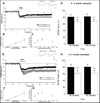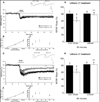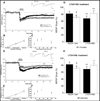Pharmacological reversal of synaptic plasticity deficits in the mouse model of fragile X syndrome by group II mGluR antagonist or lithium treatment
- PMID: 21078304
- PMCID: PMC3050427
- DOI: 10.1016/j.brainres.2010.11.032
Pharmacological reversal of synaptic plasticity deficits in the mouse model of fragile X syndrome by group II mGluR antagonist or lithium treatment
Abstract
Fragile X syndrome is the leading single gene cause of intellectual disabilities. Treatment of a Drosophila model of Fragile X syndrome with metabotropic glutamate receptor (mGluR) antagonists or lithium rescues social and cognitive impairments. A hallmark feature of the Fragile X mouse model is enhanced mGluR-dependent long-term depression (LTD) at Schaffer collateral to CA1 pyramidal synapses of the hippocampus. Here we examine the effects of chronic treatment of Fragile X mice in vivo with lithium or a group II mGluR antagonist on mGluR-LTD at CA1 synapses. We find that long-term lithium treatment initiated during development (5-6 weeks of age) and continued throughout the lifetime of the Fragile X mice until 9-11 months of age restores normal mGluR-LTD. Additionally, chronic short-term treatment beginning in adult Fragile X mice (8 weeks of age) with either lithium or an mGluR antagonist is also able to restore normal mGluR-LTD. Translating the findings of successful pharmacologic intervention from the Drosophila model into the mouse model of Fragile X syndrome is an important advance, in that this identifies and validates these targets as potential therapeutic interventions for the treatment of individuals afflicted with Fragile X syndrome.
Copyright © 2010 Elsevier B.V. All rights reserved.
Figures




Similar articles
-
PDE-4 inhibition rescues aberrant synaptic plasticity in Drosophila and mouse models of fragile X syndrome.J Neurosci. 2015 Jan 7;35(1):396-408. doi: 10.1523/JNEUROSCI.1356-12.2015. J Neurosci. 2015. PMID: 25568131 Free PMC article.
-
Functional rescue of excitatory synaptic transmission in the developing hippocampus in Fmr1-KO mouse.Neurobiol Dis. 2011 Jan;41(1):104-10. doi: 10.1016/j.nbd.2010.08.026. Epub 2010 Sep 15. Neurobiol Dis. 2011. PMID: 20817093
-
Metabotropic receptor-dependent long-term depression persists in the absence of protein synthesis in the mouse model of fragile X syndrome.J Neurophysiol. 2006 May;95(5):3291-5. doi: 10.1152/jn.01316.2005. Epub 2006 Feb 1. J Neurophysiol. 2006. PMID: 16452252
-
Fragile X syndrome and targeted treatment trials.Results Probl Cell Differ. 2012;54:297-335. doi: 10.1007/978-3-642-21649-7_17. Results Probl Cell Differ. 2012. PMID: 22009360 Free PMC article. Review.
-
Protein translation in synaptic plasticity: mGluR-LTD, Fragile X.Curr Opin Neurobiol. 2009 Jun;19(3):319-26. doi: 10.1016/j.conb.2009.03.011. Epub 2009 May 4. Curr Opin Neurobiol. 2009. PMID: 19411173 Free PMC article. Review.
Cited by
-
Using Drosophila as a tool to identify Pharmacological Therapies for Fragile X Syndrome.Drug Discov Today Technol. 2012 Sep 24;10(1):e129-e136. doi: 10.1016/j.ddtec.2012.09.005. Drug Discov Today Technol. 2012. PMID: 23730322 Free PMC article.
-
Group 1 metabotropic glutamate receptor function and its regulation of learning and memory in the aging brain.Front Pharmacol. 2012 Oct 12;3:182. doi: 10.3389/fphar.2012.00182. eCollection 2012. Front Pharmacol. 2012. PMID: 23091460 Free PMC article.
-
Glycogen synthase kinase-3: a promising therapeutic target for fragile x syndrome.Front Mol Neurosci. 2011 Nov 1;4:35. doi: 10.3389/fnmol.2011.00035. eCollection 2011. Front Mol Neurosci. 2011. PMID: 22053151 Free PMC article.
-
Testing Fmr1 KO Phenotypes in Response to GSK3 Inhibitors: SB216763 versus AFC03127.Front Mol Neurosci. 2021 Oct 7;14:751307. doi: 10.3389/fnmol.2021.751307. eCollection 2021. Front Mol Neurosci. 2021. PMID: 34690696 Free PMC article.
-
Molecular and genetic analysis of the Drosophila model of fragile X syndrome.Results Probl Cell Differ. 2012;54:119-56. doi: 10.1007/978-3-642-21649-7_7. Results Probl Cell Differ. 2012. PMID: 22009350 Free PMC article.
References
-
- Acharya JK, et al. Synaptic defects and compensatory regulation of inositol metabolism in inositol polyphosphate 1-phosphatase mutants. Neuron. 1998;20:1219–1229. - PubMed
-
- Altinbilek B, Manahan-Vaughan D. Antagonism of group III metabotropic glutamate receptors results in impairment of LTD but not LTP in the hippocampal CA1 region, and prevents long-term spatial memory. Eur J Neurosci. 2007;26:1166–1172. - PubMed
-
- Altinbilek B, Manahan-Vaughan D. A specific role for group II metabotropic glutamate receptors in hippocampal long-term depression and spatial memory. Neuroscience. 2009;158:149–158. - PubMed
-
- Bakker CE, Oostra BA. Understanding fragile X syndrome: insights from animal models. Cytogenet Genome Res. 2003;100:111–123. - PubMed
-
- Balschun D, Wetzel W. Inhibition of mGluR5 blocks hippocampal LTP in vivo and spatial learning in rats. Pharmacol Biochem Behav. 2002;73:375–380. - PubMed
Publication types
MeSH terms
Substances
Grants and funding
LinkOut - more resources
Full Text Sources
Other Literature Sources
Medical
Miscellaneous

